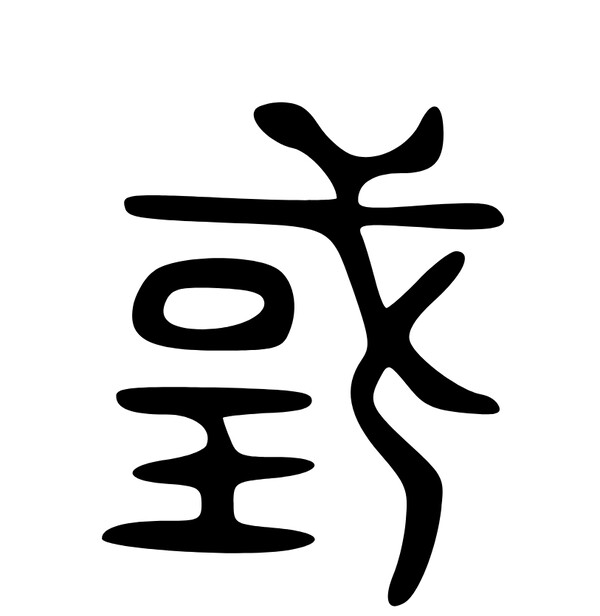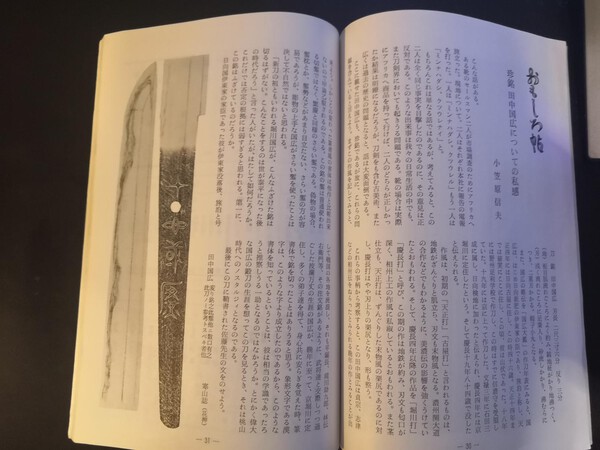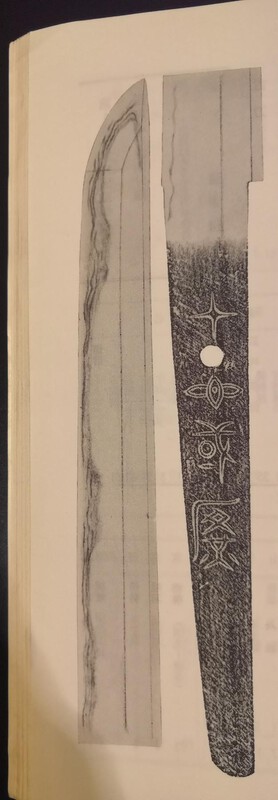-
Posts
2,170 -
Joined
-
Last visited
-
Days Won
37
Content Type
Profiles
Forums
Events
Store
Downloads
Gallery
Everything posted by Jussi Ekholm
-
I have been only keeping an eye out for early Uda stuff but here are some references. I do have some more saved up but I can link these as the links are working (some of my links are dead). Kunimitsu: https://www.aoijapan.net/tanto-mumei-attributed-as-ko-nyudo-kunimitsu/(Kunimitsu has few mumei Jūyō too) Kunifusa: https://www.touken-matsumoto.jp/eng/product_details_e.php?prod_no=KA-0259 Kunimune: https://www.samuraishokai.jp/sword/15132.html Hirakuni: https://web.archive.org/web/20140717015823/http:/www.nipponto.co.jp:80/swords/KT125609.htm Kunihisa: https://www.ebay.com/itm/Tanto-Wakizashi-Unsigned-Uda-Kunihisa-First-Muromachi-1394-NBTHK/303492988473?hash=item46a9977e39:g:PVMAAOSwsmdeTTad
-
I can't really add much thoughts on this as there has been some very good posts written already. However I would think that the Japanese organizations are mainly focused on Japanese sword collecting in Japan, they might not totally understand how many collectors there are outside Japan too (although we are still very small in number). As I do personally feel that the shinsa fees are actually quite low (NBTHK Hozon 25,000 Yen, NTHK-NPO shinsa 17,000 Yen). If living in Japan I would absolutely spend 25,000 Yen to get an informed opinion of any given sword. Of course it is completely different ballgame if you are sending your sword for shinsa from outside Japan, as then it gets lot more complicated. You and the organizations have to go by Japanese laws and you'll need an agent (or someone else) to handle the sword through the required hoops to get your sword from you to the shinsa and back to you. We have many great guys that are doing this favor for international collectors as they provide the service for us that would otherwise be unreachable.
-
Haha Hoanh I wish I had that great memory. I usually try to check my translations if I am not certain about them, and as I was checking this one I stumbled to the old thread about the same sword.
-

Oldest piece of Japanese art
Jussi Ekholm replied to kissakai's topic in General Nihonto Related Discussion
Hello Chris unfortunately the one side of mei seems too far gone for me to guess about the signature of the smith but I would guess the date to be □享二二年八月日 which could be Eikyō 永享 (1429-1441) or Chōkyō 長享 (1487-1489). But considering Chōkyō only had 3 years (as I do believe this is dated 4th year as it has double 二) and also looking at the size and shape I'd think Eikyō as the better guess from those 2, so with that line of thought I'd guess it could be dated 1432. Seems to be very interesting wakizashi. -
Mei is 雷光 The sword was discussed here few years ago: http://www.militaria.co.za/nmb/topic/27010-translation-help/
-
I think it is signed 防州住藤原貞道.
-

Help to read what paper certificate it is for Katana & Tsuba
Jussi Ekholm replied to Caracal's topic in Nihonto
Not Osafune Masamitsu as it is much later sword 芸州住出雲大掾正光 -
I do think it was/is bit unfortunate stumble by Paul who has done lots of good stuff over the years for replica collecting community with SBG. Lots of misinformation in there and I do genuinely think that his business partners in this "Blades of Japan" thing might have told him some half truths etc. duped him a bit. I tried to correct him on the info regarding the Kanemitsu tanto, that it is not THE Kanemitsu on the SBG thread. I do believe he could connect martial artists to Japanese craftsmen / 2nd hand modern martial arts swords from Japan. Unfortunately most of the stuff they have are Old NBTHK papered stuff or JTK papered stuff, and well I do think the associates in Japan have their hands on that... Not wanting to throw Paul under the bus but I cannot really accept that venture of selling those blades to collecting newbies. I did point out the affordable second hand martial art sword route as more legitimate option several times but I know the markup in there is small.
-

Fun Topic: The Unusual: Blades, etc.
Jussi Ekholm replied to barnejp's topic in General Nihonto Related Discussion
I remember asking in the previous thread if your sword has a high shinogi (a fairly large difference in thickness between shinogi and mune)? That is one fairly easy explanation for the placement in my mind. Although I do think that the placement in yours is not aesthetically the most pleasing. Here is a large suriage Motomitsu blade for reference as it has the hi at the shinogi. -

Book recommendation "Reborn"
Jussi Ekholm replied to vajo's topic in General Nihonto Related Discussion
Very good recommendation Chris. I got mine from Krystian too and there are some very rare items featured in that book that I haven't encountered yet in other books. -

Report of comments
Jussi Ekholm replied to BIG's topic in Sword Shows, Events, Community News and Legislation Issues
Thank you for the explanation Ian. -

Report of comments
Jussi Ekholm replied to BIG's topic in Sword Shows, Events, Community News and Legislation Issues
I am always surprised how much negativity in general we have in such a small hobby. I guess politics & other complicated stuff just comes in when hobby is highly specialized like collecting Japanese swords. I am just puzzled by many things that I just read in that link in the opening. I do think it is written in quite passive-aggressive tone. As Nakahara and Nakano have extreme knowledge about Japanese swords it would be interesting to hear what kind of criteria they apply on judging someones knowledge? I mean they might not understand fully that studying Japanese sword outside Japan is a bit different ball game compared to studying in Japan. I would be quite interested to know about the fake sword mentioned there. Was the NBTHK paper legitimate and was it just difference in opinion between Nakahara and NBTHK? Was the certificate a fake one? What sword that was? I do know bits and pieces of background info from various sources and I am using my own brains to think but it is like a game of broken telephone or trying to solve a puzzle with missing pieces. -

Soryu.pl Free International Shipping
Jussi Ekholm replied to Krystian's topic in Auctions and Online Sales or Sellers
Just wanted to give feedback with excellent dealing with Krystian. Purchased a small lot of books, and will surely buy again in the future. -
Chris Jumyō smith lineage was Mino tradition, so you are correct that it is indeed a Mino tanto.
-
1) Here are NBTHK shinsa prices - https://www.touken.or.jp/english/aboutus.htmlBut take note you'll need to have a person handling the item in Japan, so probably add agent fees to this as well as shipping both ways and other expenses. 2) Different prices for different levels of papers, see above 3) Getting a Hozon paper should not be a grand feat, it is higher levels when swords are struggling to pass, as they should weed out the weaker swords. 4) Old NBTHK papers carry pretty much zero commercial value. Modern NBTHK papers are the standard in the market. 5) For an affordable mumei sword (with less desirable attribution) the papers don't add much value but they will most likely help to sell it. 1800$ for katana in decent condition and koshirae with NBTHK paper in my mind seems like a good deal. The particular sword is not what I would personally go for but for that price I see it as a good deal. 6) Depends on many things for me. Of course would be amazing to get an unpapered sword up to the top but I am not a huge gambler by nature, so I might rather take a bit safer option with my limited finances. 7) One of my two swords has old green papers and I am planning to send it for new papers in the future when I feel ready for it. As you seem to be interested about prices, I think you might enjoy taking a look on this that I posted bit over year ago, some prices for old swords: http://www.militaria.co.za/nmb/topic/27828-price-list-for-old-swords/Just a note of caution, there are lot of things affecting the price of a sword and you should judge each sword as a unique item. However if you track the market on daily basis year after year you will start to get bit of a hang on things and what are some reasonable expectations. There will be reasons why some deals just seem incredibly good without knowing the details, more than often item is problematic in that case. And on the other hand there can be times where the item is expectionally high quality so it will be priced way above it's "peers". As you said yourself in your opening post it is very complicated.
-
Looks to me like Shinshintō Jumyō
-
I think it is 備後住田村正行 - Bingo jū Tamura Masayuki
-

Help with signature on Smith, Nagamaki about year 1600
Jussi Ekholm replied to Caracal's topic in Nihonto
I am on a train and just with my phone but I would guess maybe 芸州大山住宗重作 - Geishū Ōyama jū Muneshige saku Better pics would be helpful. Here is one reference mei with NTHK papers http://www.nipponto.co.jp/swords5/NT329792.htm -

Wanted: Tōken Bijutsu (Nbthk Magazine) Issues
Jussi Ekholm replied to Jussi Ekholm's topic in Wanted to Buy
I have managed to get those issues. And at the moment I am looking for those two full years above and two specific issues, 266 and 278. -
It has been really interesting. Thanks Peter and Kirill for pointing towards ancient forms of Chinese texts. I think I was able to identify quite close characters for Kunihiro in Liushutong type of Chinese characters (I am still missing first two). Here are those attached. Always interesting to hear about Ainu culture and items too.
-
Well here is the full article for those interested, this was published in NBTHK magazine 110. I am not totally sure if it is ok to post it in public like this but as the purpose is purely educational I think we can get a pass on this one. The sword seems to be made by Horikawa Kunihiro. The sword seems to be signed in very weird way but I believe experts read it as 田中国広 Tanaka Kunihiro. The real name of Horikawa Kunihiro was Tanaka Kintarō (田中金太郎). Now when you look Horikawa Kunihiro signatures you'll see that he signed Kunihiro with 國廣 (old form which is not commonly used in texts anymore) So mei 田中國廣 actually kinda fits in as you look at the picture (eyes are kinda seeing what you want to see). I was completely puzzled as I believe most were when I saw that nakago on the magazine but I had the article there to help guiding the thought process (even though I can only read it partially). And hopefully I got the thought process somewhat correctly. I believe this article series could be called something like interesting items, and this particular article is 珍銘 田中国広についての私感. At first I thought this 珍銘 (chin-mei?) would refer this weird type of signing as I couldn't find it in any of my glossaries but then I found out same kanji in other old NBTHK article and that sword had regular mei. Unfortunately I cannot fully read the text near the nakago in article but I do recognize it reads kawari-mei 変り銘 in there which I might think in this occasion means something like weird/unusual mei. And you can also see Kanzan shiruzu + Kao in the end 寒山誌 (花押).
-

Wanted: Tōken Bijutsu (Nbthk Magazine) Issues
Jussi Ekholm replied to Jussi Ekholm's topic in Wanted to Buy
Thanks for the offer about scanning Wim. I am actually trying to achieve the same continuos collection of magazine issues as you have. I am missing these two years and after these I'll start hunting late 100's some of the early 200's. It is quite fun and addicting trying to track down certain numbers, and this is form of collecting suiting my budget too. -
Well I am not too hot thread starter but as I encountered this in old NBTHK magazine I thought I'd share this one. Like the thread title says. Have you seen something like this before? Short and sweet opening post. Of course I do have the article but I've struggled to figure out what should something like this be called. I haven't found a term in any of my glossaries. Maybe it will spark some discussion who knows...
-

carving and writing on blades
Jussi Ekholm replied to Steffieeee's topic in General Nihonto Related Discussion
I posted that example above as it has writing (instead of horimono characters) on the blade which is very rare. The sword is an ōdachi in the collection of Futarasan-jinja. It is mumei attributed to Sōshū Masahiro and Nanbokuchō period. The blade length is 117,8 cm and nakago is 53,1 cm. Here is the writing on the blade. I do believe the main point of it is it was dedicated to the shrine 1474. Someone more proficient in Japanese language would be able to translate it. 奉施入中禅寺権現下州佐野庄舟越但馬守藤原高綱 / 文明六天四月日願主敬白 I believe pretty much all of the examples of tōshin-kiritsukemei I have seen have been on swords that are in the various shrines. In the masterpieces from Futarasan-jinja book 15 out of 34 swords featured have this type of writing on the blade. -

Wanted: Tōken Bijutsu (Nbthk Magazine) Issues
Jussi Ekholm replied to Jussi Ekholm's topic in Wanted to Buy
Well I've been continuing my hunt at Japanese sites. There is just so much amazing stuff available in there it is hard to keep control about buying stuff... I am still looking few years of NBTHK magazines if someone in Europe might have them. I haven't found these for sale in Japan in a long while (outside huge lots). Sometimes they can be found in huge lots but I don't need the 20+ years of magazines in the package as I already have them, just the few years that I am missing. 1985 - Issues 336 to 347 1986 - Issues 348 to 359 Same offer 50€ per year and I'll pay the shipping is still up for these two years. Now I might be tempted to buy very early magazines pre-100 too depending on the price. But as they tend to be quite expensive I am not sure if I have the budget for them right now...







